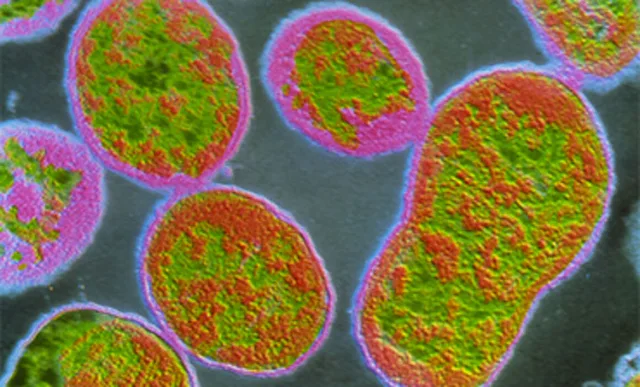OCCURRENCE AND CLASSIFICATION: The genus Brucella includes three medically relevant species; B. abortus, B. melitensis, and B. suis. These three species are the causative organisms of classic zoonoses in livestock and wild animals, specifically in cattle (B. abortus), goats (B. melitensis), and pigs (B. suis). These bacteria can also be transmitted from diseased animals to humans, causing a uniform clinical picture, so-called undulant fever or Bang’s disease.
MORPHOLOGY AND CULTURE: Brucellae are slight, coccoid, Gram-negative rods with no flagella. They only reproduce aerobically. In the initial isolation the atmosphere must contain 5–10% CO2. Enriched mediums such as blood agar are required to grow them in cultures.
PATHOGENESIS AND CLINICAL PICTURE: Human brucellosis infections result from direct contact with diseased animals or indirectly by way of contaminated foods, in particular unpasteurized milk and dairy products. The bacteria invade the body either through the mucosa of the upper intestinal and respiratory tracts or through lesions in the skin, then enter the subserosa or subcutis. From there they are transported by microphages or macrophages, in which they can survive, to the lymph nodes, where a lymphadenitis develops. The pathogens then disseminate from the affected lymph nodes, at first lymphogenously and then hematogenously, finally reaching the liver, spleen, bone marrow, and other tissues, in the cells of which they can survive and even multiply. The granulomas typical of intracellular bacteria develop. From these inflammatory foci, the brucellae can enter the bloodstream intermittently, each time causing one of the typical febrile episodes, which usually occur in the evening and are accompanied by chills. The incubation period is one to four weeks. B. melitensis infections are characterized by more severe clinical symptoms than the other brucelloses.
DIAGNOSIS: This is best achieved by isolating the pathogen from blood or biopsies in cultures, which must be incubated for up to four weeks. The laboratory must therefore be informed of the tentative diagnosis. Brucellae are identified based on various metabolic properties and the presence of surface antigens, which are detected using a polyvalent Brucella-antiserum in a slide agglutination reaction. Special laboratories are also equipped to differentiate the three Brucella species. Antibody detection is done using the agglutination reaction according to Gruber-Widal in a standardized method. In doubtful cases, the complement-binding reaction and direct Coombs test can be applied to obtain a serological diagnosis.
THERAPY: Doxycycline is administered in the acute phase, often in combination with gentamicin. A therapeutic alternative is cotrimoxazole. The antibiotic regimen must be continued for three to four weeks.
RELATED;
4. FEVER
5. DIARRHEA
6. BACTERIOLOGY












No comments:
Post a Comment